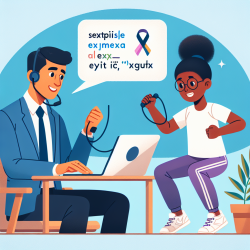Introduction
In the ever-evolving landscape of speech-language pathology, the integration of digital tools and evidence-based practices is crucial. A recent research article, "A survey of prosecutors and investigators using digital evidence: A starting point?" offers insights that can be adapted to enhance the skills of practitioners in our field. While the study primarily focuses on the legal domain, the principles of digital evidence management, training, and collaboration can be applied to improve outcomes in speech-language pathology, particularly in online therapy services like those provided by TinyEYE.
Understanding Digital Evidence in Speech-Language Pathology
The research highlights the importance of understanding and utilizing digital evidence effectively. In the context of speech-language pathology, digital evidence can include data from therapy sessions, progress tracking, and communication assessments. Practitioners must be adept at collecting, analyzing, and applying this data to tailor interventions and demonstrate progress.
Training and Specialization
One of the key findings from the research is the need for specialized training in digital evidence. Speech-language pathologists can benefit from targeted training that focuses on digital tools and data analysis. By developing expertise in these areas, practitioners can enhance their ability to make data-driven decisions, ultimately improving therapy outcomes for children.
Collaboration and Communication
The research underscores the importance of strong relationships between professionals. In speech-language pathology, collaboration with other educators, therapists, and families is vital. Effective communication ensures that all stakeholders are informed and engaged in the therapeutic process, leading to better outcomes for children.
Implementing Research Insights
- Invest in Training: Seek out professional development opportunities that focus on digital tools and data analysis. This can include workshops, webinars, and certification programs.
- Foster Collaboration: Build strong relationships with colleagues and stakeholders. Regular communication and collaboration can enhance the therapeutic process and ensure that all parties are aligned in their goals.
- Utilize Data Effectively: Collect and analyze data from therapy sessions to make informed decisions. Use this data to demonstrate progress and adjust interventions as needed.
Conclusion
By applying the principles of digital evidence management, training, and collaboration highlighted in the research, speech-language pathologists can enhance their practice and improve outcomes for children. As technology continues to evolve, staying informed and adapting to new tools and methods will be essential for success in the field.
To read the original research paper, please follow this link: A survey of prosecutors and investigators using digital evidence: A starting point?










